When you think of a speaker, the first thing that often comes to mind is its sound. But have you ever wondered how this delicate technology is protected? That’s where a metal speaker grill comes in. Custom metal speaker grills are designed to serve two main purposes: protecting the internal components and ensuring that sound passes through without distortion.
But what metal speaker grill materials are used, and how to make speaker grills effectively? Let’s take a closer look at the different production methods for metal mesh speaker grills.
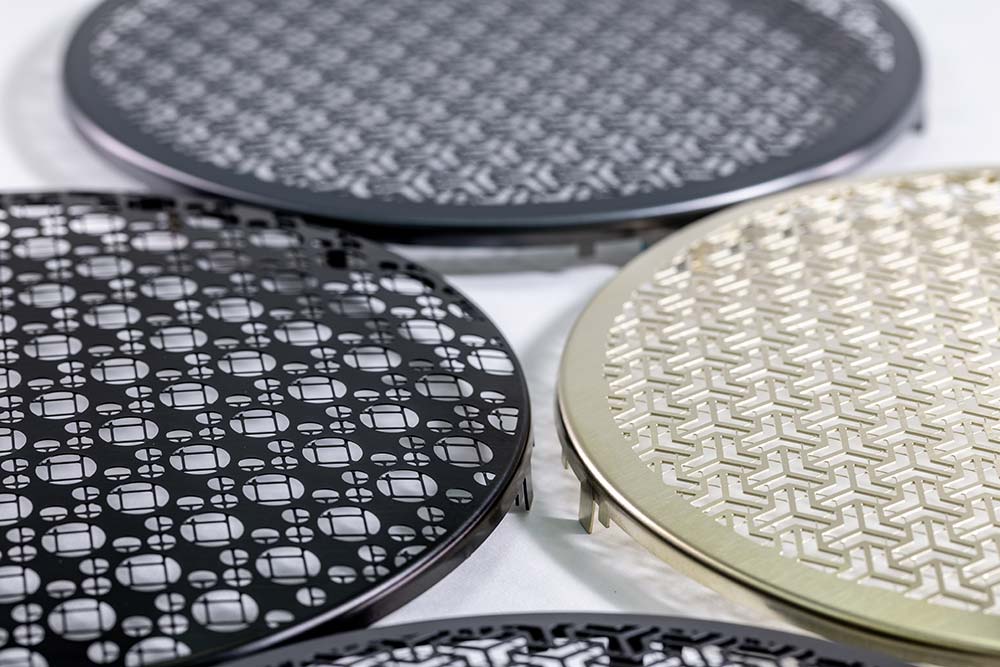
Types of Speaker Grilles
There are varieties of speaker grille types, each custom-made for particular functions, depending on the material and design. Sound quality and speaker longevity can be affected by the choice of grille. Let us zoom into some main ones:
- Mesh Grilles: These thin, soft metal speaker grills are commonly found in professional sound systems. They afford solid protection while letting the sound pass through with little distortion. In addition, a well-made speaker grill of a metal mesh sheet improves air circulation and lessens resonance among other things, hence great for studio and stage work.
- Foam Grilles: Foam grilles are typically applied on home speakers and while being fairly transparent to sound also keep dust and other debris out. They are soft, very light, and help retain the highest sound fidelity in home audio applications.
- Metal Grilles: Known for being heavy-duty, metal mesh speaker grilles provide strong protection to the inner components of high-end or commercial-grade loudspeakers. Aluminum, steel, or stainless steel are among the options available for metal speaker grille materials, depending on the required strength, resistance to corrosion, and aesthetic preference.
- Plastic Grilles: Lightweight and inexpensive, these kinds of grilles are usually found on entry-level or budget speakers. Plastic grilles are not as sturdy as their metal counterparts; however, they can be molded into various designs with ease and offer minimal protection to the internal speaker components.
Knowing differences between them is essential in selecting the right grille, according to your needs, wherein actual sound performance, durability, and aesthetics are concerned.
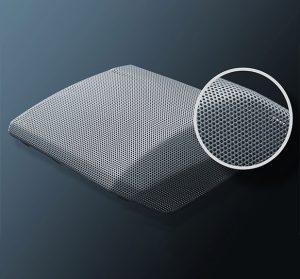
Metal Speaker Grilles Materials
Performance and longevity get seriously affected by the choice of the metal speaker grill materials, each affording particular advantages in terms of durability, sound transparency, and aesthetics. In the following, we shall analyze some of the more popular options:
Metal (Steel, Aluminum)
Metal grills are modern in design and very rugged; hence they suit commercial or high-end speakers well. Depending upon the design, some of the metal-mesh speaker grills may cause slight loss of sound transparency. So selection of the speaker grill metal mesh sheet that affords least acoustic obstruction and maximum protection is essential.

Plastic (ABS, SOP)
Plastic grilles tend to be light and cheap, ideal for entry-level or budget speakers. Easy to press into a custom mold, but not as durable as metal.
Foam and Fabric
These materials stand out in preserving sound transparency and thus are often used in home audio systems. Foam and fabric grilles allow the sound waves to pass through with very little distortion while imposing a basic level of protection against dust and other contaminates.
How to Choose the Right Metal Speaker Grills Materials
Design and Aesthetics
A grille’s design is evident in its protective function of internal components, sound diffusion, and, of course, the aesthetic flavor it imparts to the system. Quality custom metal speaker grills work in favor of both the performance and the beauty of the speaker.
Custom vs. Stock Designs
Usually, they bolster brand identity and have acoustic and visual customizations. They might be costlier than the stock designs; however, the benefits accrued to performance and brand recognition can outweigh the cost.
Durability Considerations
Life span depends largely on the material of a grille. Metal grilles last longer and resist damage, while plastic and foam grilles begin to deteriorate in harsh environments.
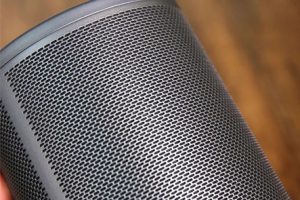
Cost Differences
Pricing depends on the production process. For large quantities, mass production methods like stamping or injection molding are cost-efficient. CNC machining and 3D printing work better for small quantities and specialized designs.
Acoustic Performance
A metal mesh speaker grill’s construction and fabrication will directly impact the performance of the speaker.
- Open Grilles: They allow better sound transmission but offer lesser protection.
- Closed Grilles: They offer more protection but might slightly change the sound characteristics.
As a global leader in custom metal speaker grills, TMNetch supplies a high-quality product that also looks good to the countries of Thailand, Vietnam, Europe, and the United States. It offers custom solutions tailored to every acoustic and design requirement, including consumer electronics, automotive interiors, or indoor applications.
How to Make Speaker Grilles: 6 Methods
Method 1: Stamping
Stamping is one of the most common types of production processes, needed mostly in the manufacture of metal speaker grills. In stamping, a flat sheet of metal die is placed in a press where it is sheared to the required configuration.
Benefits of Stamping :
- Adapts to mass production.
- Highly durable and economical for bulk quantity.
Applications:
Metal grills in the commercial speakers and the automotive speakers.
Method 2: Injection Molding
The most practical approach in the formation of plastic and foam speaker grilles is by injection molding. Plastic granules are heated in a machine until they become molten in order to be shaped in a machine.
Advantages:
- Makes it possible to come up with intricate objects.
- Use is appropriate for large scale manufacturing.
Disadvantages:
- Materials can be limited to mainly plastic and foam.
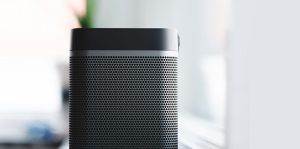
Method 3: CNC Machining
CNC machining is one of the forms of indent usage where a cutting equipment is driven therefore adopting computer technology except this time a program guides the machinery and all the cuts made and the shapes aimed are only directed on the screens. Mostly applies to the metal grille in high end speakers.
Why CNC?
- Accuracy and flexibility.
- Good for low volume production of standard and individual speaker hubs.
Method 4: Laser Cutting
This form of cutting involves the use of laser directed on materials at very high intensity hence leads to the exact cutting of required shapes of the materials. It has come into preference as it makes fine designs in metal grills.
Benefits of Laser Cutting:
- Great for intricate and complex designs.
- Suitable for both short runs and mass production.
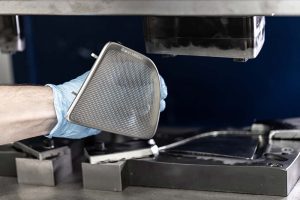
Method 5: 3D Printing
In recent years, the use of 3D printing in the production of speaker grilles has come into being. This method entails creating the grille by ‘adding’ material in a layer by layer fashion mostly using plastics.
Advantages :
Ultimate design flexibility. Great for development and limited-scale production.
Disadvantages :
At present constraints on the range of interment used and the speed of manufacture.
Method 6: Fabrication
Fabrication is the building or formation of a grille either manually or with the use of machines by bringing together pre-cut parts. It is convenient for custom or low quantity production.
Why Choose Fabrication?
- It enables customization.
- Appropriate for special or small quantity orders.
Best Custom Metal Speaker Grills Manufacturer
As a global leader in custom metal speaker grills, TMNetch supplies a high-quality product that also looks good to the countries of Thailand, Vietnam, Europe, and the United States. It offers custom solutions tailored to every acoustic and design requirement, including consumer electronics, automotive interiors, or indoor applications.
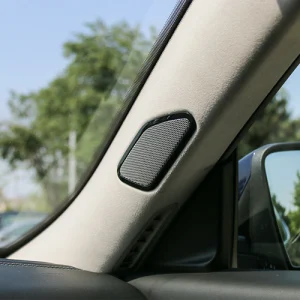
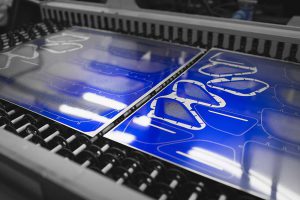
With over ten years of experience in manufacturing metal mesh speaker grills, TMNetch specializes in fully customized services. Our etching shop is housed in a building stretching three stories and 4,000 square meters. It comprises five fully automatic photochemical etching production lines stretching 39 meters in length. We manage any phase from consultation and ordering through production, quality inspection, and delivery at our facilities without involving third parties, thus cutting down the final price.
With our advanced metal speaker grille production technology, high volume output can be guaranteed, and production cycles greatly shortened for quicker turnover. We also provide all kinds of secondary processing, including metal laser cutting, bending, polishing, color painting, and plating, for the complete customization of your custom metal speaker grille.
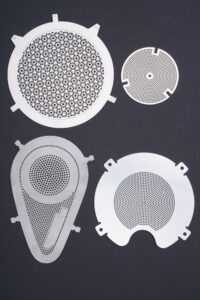
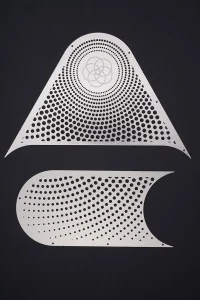
FAQs about Metal Speaker Grills
Q1: Do metal speaker grills affect sound?
Yes, depending on the design and material, a metal speaker grille can have an effect on the transmission of sound. Properly designed grilles strike a balance between protecting the loudspeaker and allowing the sound to go freely, producing clear and true sounds.
Q2: How to make speaker grills?
Metal speaker grills are usually manufactured by photochemical etching, laser cutting, CNC machining, or stamping. All these processes have different advantages depending on precision, volumes, and customizability.
Q3: What materials are used in metal speaker grills?
All major materials for metal speaker grills include aluminum, steel, and stainless steel. Each of these materials has different advantages for durability, corrosion resistance, and acoustic performance.
Q4: Can I order custom designs?
Yes, TMNetch specializes in custom metal speaker grills. You can select the size, shape, mesh pattern, finish, and any secondary processes to meet both aesthetic and acoustic requirements.
Q5: What applications are suitable for metal speaker grills?
Metal speaker grills suit professional audio equipment, high-quality home audio, automotive interiors, and any setting where durability, protection, and a certain degree of acoustic transparency are desired.
Summary
Choosing the safe metal speaker grill involves the metal, design, durability, and acoustic performance. Speaker grill metal mesh sheets to fully custom metal speaker grills-understanding these factors will give you the best protection and sound quality possible.
TMNetch is one of the good manufacturers who can stand behind a metal speaker grill to be of the highest quality, long-lasting, and beautiful, yet it is a solution for any design anywhere in the world and for many purposes. Whether it is in bulk or a fully customized design, TMNetch has enough people, knowledge, and facilities required to meet your every expectation.
